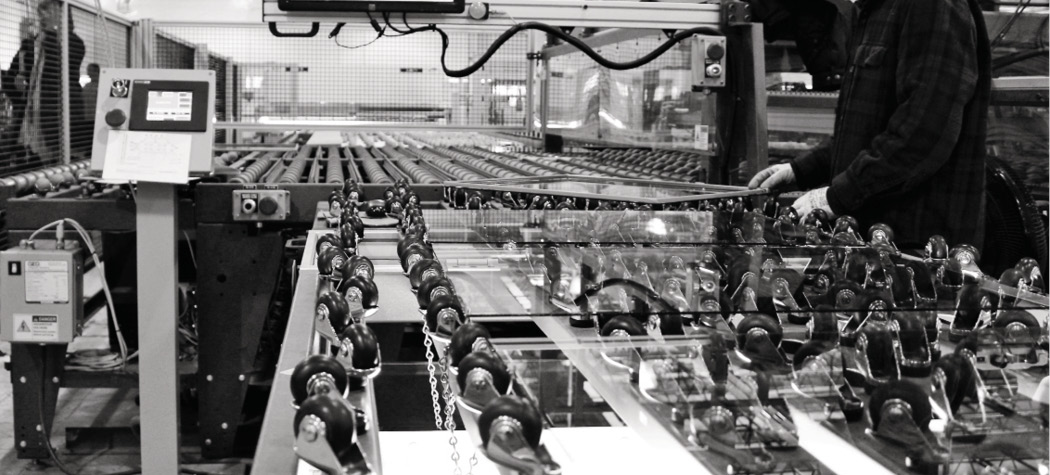Factory View: An Eye to the Future
Manufacturers are re-imagining how their processes work as they navigate a new set of challenges brought on by the coronavirus pandemic

Image courtesy of Crystal Window & Door
Component and end-product manufacturers in the residential fenestration industry all seem to agree on one thing: the coronavirus pandemic and its associated effects are unprecedented and have caused businesses to alter and re-think how they operate.
Despite H1N1 laying a foundation for crisis communications and operations in 2009, says Jeff Inks, senior vice president – advocacy, with the Window & Door Manufacturers Association, “there’s nothing that could have prepared the manufacturers for dealing with the pandemic we’re dealing with in such a widespread case in every state.”
As of press time, much remains unknown about the pandemic. How long will it last? Will there be a second wave? What will the long-term economic fallout be?
“One of the biggest challenges has been the sweeping executive orders in nearly every state and many larger metropolitan areas may have even more stringent orders that are enforced by local jurisdictions,” says Inks. “It’s a patchwork of executive orders, many of which may not be as clear as they could be with respect to how they are applied in terms of essential businesses.”
That uncertainty is especially tough for manufacturing. “Manufacturing is about having a repeatable process, fulfilling demand and meeting customers’ orders,” says Bob Keller, president of PGT Innovations’ southwest business unit.
Modified practices on the manufacturing floor
To maintain social distancing, many companies transitioned office workers to working at home, but that’s not practical for hands-on manufacturing jobs. Instead, companies are modifying industrial hygiene practices to create as safe an environment as possible. Inks says some of the common changes include handwashing stations, handwashing breaks several times per shift, cleaning of work areas multiple times per shift, and visual aids and other markers that indicate six-foot distances, particularly in heavily trafficked areas like near the time clocks.
“Some of those practices may become permanent because the world is forever changed. It’s important we follow a lot of good hygiene practices wherever we are,” says Inks. He continues that implementing such practices not only keeps employees physically healthy, but also gives them confidence that their company encourages a safe workplace.
Jana Goodrich, CEO of Seaway Manufacturing Corp., confirms these practices are in play at the plant in Erie, Pa. “We are operating at what I believe will be the new normal for a while, at least until the end of this year,” she says, mentioning measures such as disinfecting, extra cleaning several times per week, additional separation of workers, and redesigned work stations and procedures. “Breaking meetings into several smaller groups or having them electronically … sharing information to ensure proper social distancing, additional PPE, working from home where possible, and additional sick/personal time away from work are here to stay for quite a while, in my opinion.” The resulting frustrations and inefficiencies, she says, have become part of the cost of doing business.
Veka Inc. employees wear face masks and practice social distancing guidelines, among other safety practices. “It’s a different feel when you walk on the shop floor and see the social distance markings on the floor,” Joe Peilert, president and CEO, says. Veka had one isolated confirmed COVID-19 case at its Reno facility at press time. Team members and customers were notified, and a third-party hazmat certified provider cleaned and disinfected the space to allow for continued production with minimal interruption, says Peilert.
PGT Innovations adjusted production schedules and operations to promote social distancing, as well as implementing work-from-home programs where possible and banning air travel, says Keller. “Some of that temporarily impacted the capacity of some lines,” he says. “We’re working to get that capacity back through other means.” Because some production lines have fewer people, Keller explains PGT is spreading people across previously unused shifts to maintain capacity, but with a different shift structure. “It varies by line depending on how severe it is and what impact it has,” he says.
Late last year, PGT started doing virtual equipment runoffs for new equipment. The OEM runs the equipment for 24 hours with cameras on it, which PGT engineers interact with. This negates the need to send anyone to the location for the equipment runoff.
Similarly, if technical equipment goes down and needs maintenance, Keller anticipates these virtual check-ins could be an opportunity for augmented reality to get a boost. Several equipment manufacturers already provide such technology.
Supply chain realities
Supply chain health largely relies on public health orders and whether a business is classified as essential. Because company operations and capacity vary so much by state, Inks says clear communication between manufacturers and suppliers is critical. While he isn’t aware of any significant supply chain disruptions among WDMA members at this time, he asserts that managing supply chains is “always something that is critical to the product, pandemic or not.”
Veka is in what Peilert calls a “solid position,” which he attributes to being a global company with certified supply chains feeding into its production, as well as having backup plans. “All of those things coming together now are being put to the test, and it’s working. It’s not easy, but it’s working. That doesn’t mean there might not be any disruptions going forward, but right now we don’t see any,” he says.
Peilert says Veka takes special care with its outbound shipping area. Markings and signs in the area indicate where drivers can come in and direct them to facilities. Veka also gives each driver a thank-you package with snacks and water. “[Trucking delivery personnel] are the ones that travel all over the country and are getting exposed to so many different environments,” says Peilert.
Keller shares that “material procurement has been an interesting challenge and probably one of the larger challenges to manage.” He credits a strategic sourcing team with managing supply chain challenges and, as of late April, has not had to alter operations or reduce capacity because of supplier challenges. “We have had to move supply between suppliers as the different shutdowns have created a fluid environment,” he says.
For Seaway Manufacturing, Goodrich reports that the incoming supply chain is adequate for the most part. “We stock and order in advance so have not been negatively impacted by any protracted lead times in the market so far.” Outgoing, however, is a problem. “Most of our dealer base has now been shut down for between one and four weeks. Initially, they continued to send in orders and accept deliveries, but those who have remained under stay-at-home or shutdown orders are now refusing any deliveries due to fully loaded or overloaded warehouses and receiving areas.”
Not knowing how long dealers will be restricted from installing products or even measuring for the products they have sold via electronic sales calls, Goodrich says, means they are also holding orders so as not to run up their accounts payable and work awaiting installation.
The future
Although the year started strong for many manufacturers, the end likely will look very different. Manufacturers agree they haven’t yet felt the full economic effects of the coronavirus. “We’re hopeful the economy will begin reopening in Q2, which will allow us to get a better understanding of how much ordering will be impacted and for how long,” says Keller. “We expect to achieve our sales growth goals over the long term and feel like this is a shorter-term impact to our demand. We just don’t know how short-term and how deep and long that will be.” In the meantime, however, Keller says PGT is producing “as many windows as we possibly can to fill the demand we have.”
On the supplier side, Roto told us it expects a 20 to 30 percent decline in incoming orders through the next few months. Its forecasts are based on GDP outlook, customer input and “gut” feelings about future demand, according to Dan Gray, director of sales.
The company also is reevaluating the rest of the year. “Our biggest challenge is determining the future demand for incoming purchase orders from customers,” Gray says. “We are looking at the next nine months differently than we were looking at them at the beginning of Q1.”
Peilert reports Veka also saw a drop in demand for a period in late-March and April. He initially anticipated this economic downturn would see a sharp, rapid drop and a sharp, rapid recovery. Based on worldwide conditions, though, he now predicts a longer recovery with some setbacks and significant geographic differences. “I now believe it might take us until the end of the year to return to run rates we saw in 2019,” he says. “There’s no expectation we’d return quickly to anything that resembles normal—uncertainty will be the new normal for a while.”
It’s an ever-evolving forecast, to be sure, agrees Goodrich. Based upon customer input and what is happening on its retail side, she says that Seaway anticipates a significant pent-up demand. “If so, and the economic state of the American homeowner returns to what it was, we would still anticipate a year of at least modest growth,” she says.
The flip side is the unknown of what disposable income will remain available to homeowners once the situation eases, she continues. “There are just too many unknowns to forecast reliably at this point.”
With so much uncertainty, it is difficult to concretely plan a return to normal. “What is returning to normal?” says Keller. “With any shock like this to a market or industry, you really have to fall back on good leadership to quickly adjust to whatever the new normal is. … Strong leadership will figure out a way to get through the challenging times and find opportunity in the middle of it.”
Goodrich has similar sentiments. “No one can be sure they’re always going to make the correct decision,” she says. In order to be successful, she believes, companies “need to be decisive and take action guided by our best judgement relative to the best facts and information we have available to us at any one time, and with the attitude that we are going to survive and prosper through this mess and come out the other side better/stronger people, better/stronger managers, and better/stronger companies.”
Regardless of changes to the world status and manufacturing specifically, Inks believes manufacturers are responding to COVID-19 “with an eye to the future about a second or perhaps even third wave of this and being better prepared in a different way than we were prepared for this one.”


